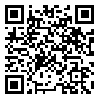Volume 56, Issue 2 (30 1998)
Tehran Univ Med J 1998, 56(2): 13-21 |
Back to browse issues page
Download citation:
BibTeX | RIS | EndNote | Medlars | ProCite | Reference Manager | RefWorks
Send citation to:



BibTeX | RIS | EndNote | Medlars | ProCite | Reference Manager | RefWorks
Send citation to:
Oliaiy G, Akbari M, Nakhaiy A. Evaluation of the effect of loads on static & dynamic parameters of vertebral collumn in 32 young males. Tehran Univ Med J 1998; 56 (2) :13-21
URL: http://tumj.tums.ac.ir/article-1-1568-en.html
URL: http://tumj.tums.ac.ir/article-1-1568-en.html
Abstract: (6379 Views)
The effect of some anthropometric factors and loading on paravertebral muscles was tested in this study. Thirty two healthy men with mean age of 25.25 years participated in this study. They didn't have history of low back pain since 12 months ago. The effect of weight, height, upper limb length, abdominal & chest circumference and upper body height and other factors e.g. body mass and functional capacity indexes on maximum isometric torque of paravertebral muscles and spinal range of motion in all planes of movement and effect of loading with 0, 5, 10, 15 kg loads on paravertebral factors e.g. dynamic torque, velocity, work, power, and slope of torque was examined with a dynamometer named ISOSTATION B-200. Correlation, analysis of variance and t-test was used in SPSS program. Results show that maximum isometric torque and functional capacity index increased with increasing weight abdominal and chest circumference and body mass index (P<0.05). Height, upper body height and upper limb length don't have effects on this factors, and anthropometric factors don't have effects on range of motion. Maximum dynamic torque, maximum velocity, work and power were significantly increased and time of movement & slope of torque were significantly decreased while load increased (P<0.05). This study showed that load-velocity relationship in limb muscles can not help the paravertebral muscles studies because paravertebral muscles histologically differ from limb muscles.
| Rights and permissions | |
 |
This work is licensed under a Creative Commons Attribution-NonCommercial 4.0 International License. |





